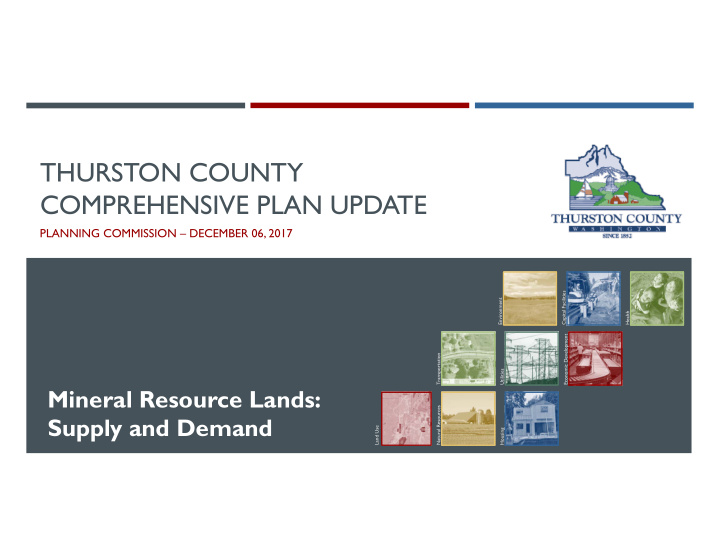



THURSTON COUNTY COMPREHENSIVE PLAN UPDATE PLANNING COMMISSION – DECEMBER 06, 2017 Capital Facilities Environment Health Economic Development Transportation Utilities Mineral Resource Lands: Natural Resources Supply and Demand Land Use Housing
OVERVIEW Supply and Demand Considerations Planning Commissioners Feedback on Draft Map Options (11/15/2017 materials) Staff have requested a recommendation from the Planning Commission on the scope of the Mineral Lands Designation Criteria and Map.
MINERAL RESOURCE LANDS Project Steps for Mineral Resource Lands 1. Identify and classify Develop a countywide inventory based on geologic data on the location and extent of mineral deposits, existing land uses, and other factors. These areas are Comp Plan Update categorized based on their quality, using available data from DNR, USGS, and others Identify priority areas where high quality mineral resources are available and compatible with existing land use patterns and other criteria. 2. Designate 3. Conserve Establish policies that ensure future land uses will be compatible with mineral extraction in designated areas. 4. Permit New mining operations planned in areas designated as mineral resource lands will still need to be reviewed before they are permitted to operate. Mining activities must abide by all relevant state and local regulations, including environmental rules.
SUPPLY AND DEMAND - AGGREGATE Sand and Gravel (Aggregate) “In designating mineral resource lands, counties and cities should determine if adequate mineral resources Supply are available for projected needs from currently designated mineral resource lands.” Inventory T otal = 6.1 billion tons^ - WAC 365-190-070 Demand 3,782,100 tons per year^ 13.5 tons per person/per year* ^ Source: AESI (2017), “Thurston County Mineral Lands – Geologic Inventory and Classification Study.” * Source: Pacific Lutheran University (2003), “The aggregates industry in Washington.”
SUPPLY AND DEMAND - AGGREGATE Sand and Gravel (Aggregate) “Counties and cities may consider the need for a longer Thurston Co. Population Estimate planning period specifically to address mineral resource lands, based on the need to assure availability of 2035 (~20 years): 370,600* minerals for future uses, and to not inadvertently preclude access to available mineral resources due to 2067 (50 years): 710,000^ incompatible development.” Aggregate Demand Estimate - WAC 365-190-070 In 2067: 9.8 million tons 20-year, cumulative (2017-2037): 88,427,354 tons 50-year, cumulative (2017-2067): 261,725,603 tons * Source: TRPC Small Area Population Estimated and Population and Employment Forecast, 2014. Total Thurston County population estimate. ^ Source: Office of Financial Management, high-range estimate. Note: This is a more extreme estimate than Thurston County typically uses.
SUPPLY AND DEMAND – BEDROCK / QUARRY ROCK Supply Can’t be estimated because depth of resource is unknown Demand Columbia Quarry produces a unique, high-density material used for jetties (gabbro) 665,280 tons sold, 1999-2017 Est. 1.5 million tons required to repair Columbia River jetty Other local material mostly doesn’t meet WSDOT specifications, but is used for other projects
SUPPLY AND DEMAND Is Thurston County a net importer or exporter of mineral resources? Hard to say – information not readily available, and often proprietary Likely a net exporter of aggregate; net importer of quarry rock December 20 th speakers to address regional market considerations
DESIGNATION CRITERIA OPTIONS Draft Mineral Resource Lands Designation Options Map 1. Broad approach Map 1. Current Criteria in Comprehensive Plan Designation Map 1a. Co-designates Agricultural Lands Stage Map 2. Narrow approach Excludes ALL criteria that have been discussed Map 3. Blended Designation area is the same as Map 1 Permitting Stage Identifies “review area” that may overlap with critical areas and other criteria Map 4. 2004 Mineral Lands Task Force Criteria
DESIGNATION CRITERIA OPTIONS Current 2017 Map 1 Map 1a Map 2 Map 3 Map 4 MRL Inventory Designation Maps some Maps Current Also Excludes all Shows Map 2 2004 mine parcels resources Comp includes critical areas, exclusionary MRL Task based on Plan LTA historic sites, criteria as a Force geology Criteria LAMIRDs, etc “review area” Criteria Total Acres 5,623 189,475 141,554 143,776 104,502 141,554 161,752 % of n/a - 75% 76% 55% 75% 85% Inventory Aggregate - 6.1 2.8 2.9 0.8 2.8 4.3 supply est*. (826 million) (billion tons) Years supply - 600 285 295 84 285 438 * Very rough estimate – uses an average estimate to convert cubic yards of material to tons
NEXT STEPS Refine MRL Map Options based on Planning Commission feedback December 20 th speakers DNR – John Bromley County Current Planning – Tony Kantas Washington Aggregate and Concrete Association – Bruce Chattin Set a public hearing
Questions? Staff Contact: Allison Osterberg, Senior Planner osterba@co.thurston.wa.us Capital Facilities Environment 360-754-3355 x7011 Health After December 15: 360-867-2102 Economic Development Transportation Maya Bühler, Associate Planner Utilities buhlerm@co.thurston.wa.us 360-786-5578 Natural Resources Land Use Housing
EXISTING DESIGNATION CRITERIA: TC COMPREHENSIVE PLAN Minimum Designation Criteria: Chapter 3 1. Mineral Deposits Should contain deposits based on USGS maps, DNR permits, or site This information is being specific geologic information provided/updated in the inventory 2. Location Not adversely impact nearby land uses, public health or safety 1,000 ft from public preserves, • urban growth areas (UGAs) • residential areas with existing densities > 1/5 • 60% of area within 1,000 ft of a proposed site must have parcels of 5 acres or larger (excludes applicant) 3. Minimum Site Size 5 acres 4. Marketability Mineable, recoverable, marketable 5. LTA and Historic Long-term agriculture lands and historic/cultural sites are excluded 6. LTF Long-term forestry lands may be co-designated
EXISTING DESIGNATION CRITERIA: TC CODE (20.30B) Minimum Designation Criteria: 20.30B TCC Most Criteria are the same as in the Comprehensive Plan EXCEPTION A full critical area review is Site does not contain the following critical areas: Zone 1 or Zone 2 • Critical Areas done at the time of areas for Group A public water systems, Class 1 or 2 wetlands or application. their buffers, FEMA 100 ‐ year floodplains, habitat areas for threatened or endangered species or their buffers Site is located away from geologically hazardous areas (steep • slopes)
Recommend
More recommend